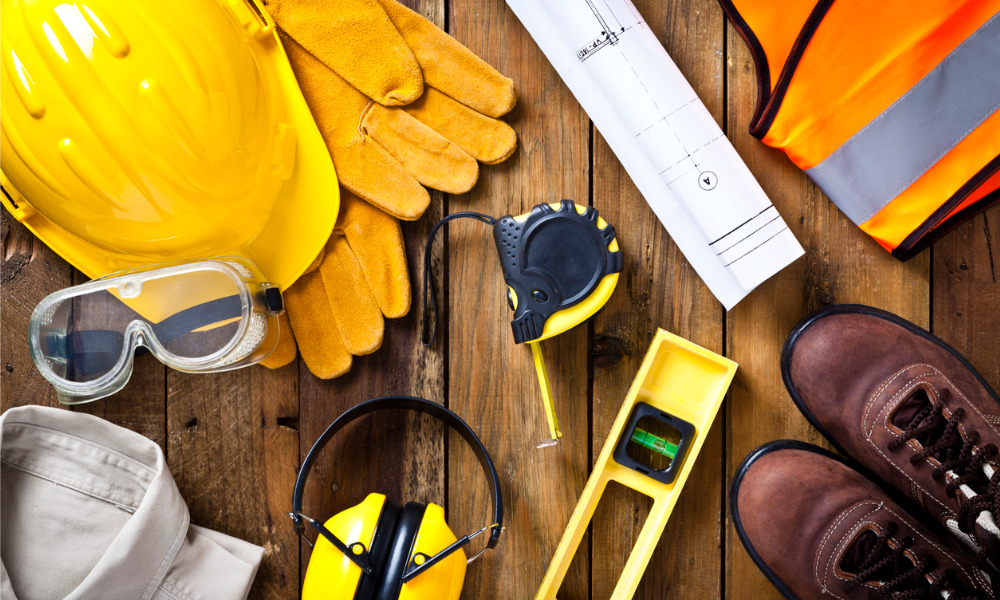Work site safety is a journey, not a destination. The journey requires constant vigilance and attention to detail. Approximately 150,000 construction site injuries are reported every year in the US. Many of these injuries could have been avoided by attention to detail and following critical safety protocols. Embedding safety and security into the culture of a job site is essential to avoiding serious injuries.
At REDCOM, we value the safety of workers and strive to ensure that every job site meets the most stringent safety regulations. REDCOM utilizes unannounced site visits by qualified personnel, such as REDCOM’s Lead Site Supervisor/Safety Officer, Donald Gumm (OSHA40 certified), to enforce safety and report progress weekly. REDCOM’s site supers are required to be OSHA30 certified, and team meetings and OSHA-required toolbox talks reinforce the company’s safety requirements.
We recognize that construction sites present a variety of challenges and dangers. Safety is not just a word; it is a mindset. The first step to avoiding danger is recognizing it. Below we will explore ten common job site dangers and how to recognize and avoid them.
1. Falls from Heights
One of the most prevalent construction safety hazards is falling from heights. Working on elevated surfaces without proper safety precautions can have devastating consequences. The sudden impact of a fall can lead to broken bones, head trauma, spinal injuries, and even death.
Some of the easiest ways to avoid height related hazards include:
- Use fall protection systems such as harnesses, guardrails, and safety nets to stop falls from heights and minimize the chances of ground impact.
- Regularly inspect scaffolding, ladders, and elevated work platforms to ensure they are structurally sound. At REDCOM, our supervisors inspect the job sites multiple times every day to ensure that equipment is safe and secure.
- Provide adequate training on working at heights. This includes proper climbing techniques, personal protective equipment uses, and hazard recognition.
2. Falling Objects
A construction site is constantly in flux. Materials and workers change locations continually. All this movement requires massive oversight to ensure all materials are safety transported and
stored. Loose and non-secured objects can easily become falling objects that can present tremendous safety hazards to workers. Objects that fall from elevated work areas can cause severe head injuries or even fatalities. Factors such as weight, height and velocity can lead to unpredictable outcomes so taking all possible precautions ultimately saves lives.
Some ways to reduce the chance of a falling object injury are:
- Secure tools and materials properly when working at high heights to prevent accidental drops by workers.
- Erect barricades or safety nets to protect workers below from falling objects.
- Ensure workers wear hard hats and other appropriate PPE at all times to provide head protection. Donald Gumm, REDCOM’s Lead Supervisor/Safety Officer, believes that “proper PPE for all” is the golden rule of construction site safety.
3. Electrical Hazards
Electricity is unique in its ability to create a wide variety of workplace hazards that include electric shocks, burns, fires, and electrocution.
Exposed wiring, faulty equipment, and/or improper handling of materials and equipment can lead to many severe injuries or loss of life on construction sites. The invisible nature of electricity makes this type of hazard particularly treacherous. Having robust and comprehensive electrical safety practices and protocols in place will keep electricity in the wires where it belongs and workers safe on the job.
Sometimes honored electrical safety protocols to adhere to include:
- Identify and mark all electrical sources, including live wires and equipment, to raise sight awareness. In addition, require all visitors and anyone who is unfamiliar with the job site to have a supervisor with them at all times to prevent accidents.
- Use ground fault circuit interrupters to protect against electrical shocks.
- Provide proper training on electrical safety, emphasizing the importance of lockout and tagout procedures and the use of insulated tools that minimize the chance of shocks.
4. Trenching and Excavation Hazards
Trenching and excavation pose significant risks at construction sites due to the potential for cave-ins, falls, and exposure to hazardous materials. In addition, unstable soil, inadequate protective systems, and improper ventilation can lead to catastrophic accidents and even fatalities.
Some ways trenching and excavating can be made safer on construction sites are:
- Conduct soil analysis to determine its stability and take necessary precautions before excavating, such as shoring or sloping the excavation.
- Install protective systems such as trench boxes to prevent cave-ins and collapses.
- Implement regular inspections and maintain proper ventilation to prevent the accumulation of hazardous gasses.
5. Hazardous Materials
The safe transport, housing, and handling of hazardous materials help to mitigate severe health risks and environmental damage. Chemicals, asbestos, lead-based paints, and other toxic substances can lead to respiratory problems, poisoning, and long-term health complications on construction sites. Improper handling, storage, or disposal of dangerous materials can cause accidental exposure to workers and nearby communities.
Protocols to keep workers who are handling hazardous chemicals safe include:
- Identify hazardous materials present on the site and create a detailed inventory.
- Provide training on handling, storage, and disposal of hazardous substances.
- Use personal protective equipment such as gloves, goggles, and respirators when working with hazardous materials.
6. Heavy Machinery Accidents
Heavy machinery, including cranes, bulldozers, and forklifts, can pose serious risks to operators and those working nearby. Improper operation, lack of training, or mechanical failures can lead to incidents such as entanglement, struck-by accidents, or machinery overturning. Additionally, heavy machinery\’s sheer size, weight, and power amplify the construction site risks involved.
Machinery safety protocols to consider:
- Ensure all operators are properly trained and licensed to operate specific machinery.
- Establish clear communication protocols between machinery operators and other workers.
- Regularly inspect and maintain machinery to ensure safe and reliable operation, including checking for faulty brakes, proper signage, and functioning safety devices.
7. Slips, Trips, and Falls
Slips, trips, and falls can cause injuries ranging from minor bruises to severe fractures and head trauma. Uneven surfaces, debris, poor housekeeping, and inadequate lighting significantly increase the risk of injury on job sites.
Ways to prevent slips, trips, and falls at construction sites include:
- Maintain clean and organized work areas, removing any clutter or obstacles that could cause trips and falls.
- Ensure adequate lighting in all work areas to improve visibility and reduce the risk of these types of accidents.
- Implement regular housekeeping practices to promptly address spills, fallen debris, and other potential slip hazards.
8. Noise and Vibrations
Prolonged exposure to excessive noise levels can cause hearing loss, while vibrations from heavy machinery can cause fatigue and musculoskeletal disorders. These conditions can impair workers\’ concentration, communication, and physical abilities, increasing the likelihood of accidents and errors.
Some of the best ways to avoid noise and vibration construction site hazards are:
- Provide workers with appropriate hearing protection, such as earmuffs or earplugs, and ensure their proper use.
- Conduct regular noise level measurements to identify areas requiring noise control measures.
- Implement engineering controls, such as sound barriers or acoustic enclosures to reduce noise and vibrations.
9. Heat and Cold Stress
Heat exhaustion, heat stroke, hypothermia, and frostbite are just some of the heat and cold stress-related dangers workers face at construction sites. In addition, working on construction sites in extreme temperatures can lead to dehydration, fatigue, impaired cognitive function, and even organ failure. The physically demanding nature of construction work exacerbates these risks.
REDCOM’s Lead Supervisor/Safety Officer, Donald Gumm, states “It’s rare to recover from heat exhaustion. The heat is worse than cold temperatures. Supervisors are trained to treat and prevent heat exhaustion and ensure that shade and hydration breaks are taken frequently. Each trailer is stocked with several cases of water.”
To prevent temperature-related health issues:
- Provide regular breaks in shaded or temperature-controlled areas during hot weather to prevent heat-related illnesses.
- Ensure workers have access to adequate hydration and encourage them to drink water frequently in hot or cold weather.
- In cold weather, provide appropriate clothing, such as insulated jackets and gloves, to protect against cold stress.
10. Manual Handling and Ergonomic Hazards
Improper lifting techniques, repetitive motions, and awkward postures can lead to strains, sprains, and chronic pain in the back and various other joints.
These injuries can be prevented through safety precautions, such as the ones listed below:
- Provide training on proper lifting techniques, including knee bending and using leg muscles instead of the back.
- Use mechanical aids, such as cranes or forklifts, to assist with heavy lifting whenever possible.
- Design workstations and tools ergonomically to reduce strain on the body and minimize repetitive motions.

